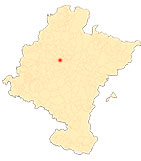pathway Teresian in Pamplona
Canvas of Saint Theresa with Christ at the Carmelite column
The arrival of this canvas along with those of the rest of the altarpieces is specified by some payments from the year 1627. It is the only one of those made by the master from Burgos, Fray Diego de Leiva, that has survived.
The textual source of this topic, a classic in Carmelite iconography, is provided by the saint herself in the book of her Life (chap. XXXIX). Among the great masters who depicted this passage at the time when Leiva was painting it for Pamplona was Gregorio Fernández himself, who did it for the church of the saint in Avila, although the column of Christ is leave, following a model more in keeping with the times in which the column of the church of Santa Práxedes had become the model to follow, in the conviction of following in this way the historicity and propriety that the post-Tridentine church demanded of artists.
The canonisation of Saint Teresa had just taken place in 1622, in the midst of the Counter-Reformation, after a process of dissemination of her sanctity throughout Spain. Her iconography was developed in that first post-Tridentine period, austere times, when the triumphal Baroque had not yet made its presence felt, and therefore neither had the trickery of rhetoric and propaganda. It was a matter of convincing and indoctrinating with images, after the conciliar reformism, with the exhibition of a truth, a reality and a property or historicity. It was still a time of a certain restraint, in the orbit of such characterful figures as St. Charles Borromeo, Molanus or Cardinal Paleotti. The characteristics that the post-Tridentine Church demanded for devotional images are fulfilled to the full in this painting: decorum, simplicity, respect, nobility of the effigies, historical honesty and truthfulness.
This restraint, again with austere colour and tenebrism, is evident in the painting of the Carthusian monk, who is depicted with a tightly drawn figure. The figure of Christ still retains evident traits of Romanesque Mannerism, while the saint is more truthful and realistic, in keeping with the artistic trends of the time.
-
FERNÁNDEZ GRACIA, R., "El convento e iglesia de los Carmelitas Descalzos de Pamplona. Architecture", Príncipe de Viana, 164, 1981, pp. 787-818.
-
ECHEVERRÍA GOÑI, P. and FERNÁNDEZ GRACIA, R., "El convento e iglesia de los carmelitas descalzos de Pamplona. Exorno artístico", Príncipe de Viana, 164, 1981, pp. 819-891.
-
AZANZA LÓPEZ, J. J., Arquitectura Religiosa Barroca en Navarra, Pamplona, Government of Navarre, 1996.
-
FERNÁNDEZ GRACIA, R., El retablo barroco en Navarra, Pamplona, Government of Navarre, 2003.
-
FERNÁNDEZ GRACIA, R., The Immaculate Conception in Navarre. Art and devotion during the centuries of the Baroque Mentors, artists and iconography. Pamplona, Eunsa, 2004.
-
FERNÁNDEZ GRACIA, R., Engraving, Counter-Reformation and Teresian Carmel. The collection of engravings of the Discalced Carmelites of Pamplona and Leonor de la Misericordia (Ayanz and Beaumont). Pamplona, I. G. Castuera, 2004.
-
FERNÁNDEZ GRACIA, R., "Santa Teresa", Juan de Goyeneche y el triunfo de los navarros en la Monarquía Hispánica del siglo XVIII, Pamplona, Fundación Caja Navarra, 2005, p. 352.
-
FERNÁNDEZ GRACIA, R., "Algunas esculturas napolitanas en Navarra", Pulchrum. Scripta in honorem Mª Concepción García Gainza, Pamplona, Government of Navarre, department de Cultura y Turismo-Institución Príncipe de Viana, 2011, pp. 300-310.
-
TARIFA CASTILLA, M. J., "Aparición de Cristo a Santa Teresa", Pamplona y San Cernin 1611-2011. IV Centenary of the Vow of the City, Pamplona, Pamplona City Council, 2011, p. 176.












